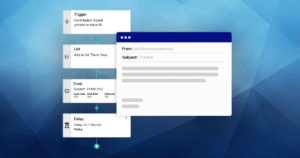Raising money for an election campaign can be daunting if you’re not sure where to start.
Fortunately, there are steps you can take today to start getting donors through the door and contributing to your cause.
Whether you’re new or experienced, these steps will help you create a scalable fundraising process.
In this post, we’re looking at how to raise money for a campaign.
(include a call to action here)
How To Raise Money for an Election Campaign
There are many ways to raise funds for your campaign, some more effective than others.
Here are the 7 steps we’d recommend based on our research:
- Create a simple website
- Get donors to your website
- Gather contact details
- Request donations
- Collect contributions
- Sell campaign merchandise
- Grow your community
This is the most scalable way to raise money for a campaign, especially if you have a small team or limited resources.
Avoid strategies that don’t scale well, because you’ll soon reach your limits and your systems will break down.
#1 Create a simple website
No campaign is complete without a website explaining your policies and showcasing your success stories.
It doesn’t need to be very fancy or have hundreds of pages, as long as it clearly states your objectives and explains how people can get in involved. Most campaigns only need a single page website with a budget of $1000-$2000 if you need one built.
Information your website must include:
- Your party’s branding (colors, fonts, and slogans)
- Your candidate’s picture and information to grow trust
- Outlines of your most important policies and legislative efforts
- Key campaign statistics to impress potential donors
- Images from your campaign to connect and relate to donors
- Contact and volunteer forms for people to get in touch
- Donors forms to encourage contributions (and pledges)
- Free downloadable resource (explained below)
- Online shop to sell merchandise (explained below)
You might be tempted to overload visitors to your website with information, but try to avoid this. Websites typically get less views than social, email, or your donation page.
The clearer your message with a clear path for donors to follow, the better your website will perform.
#2 Get donors to your website
This is normally the tricky part, getting donors to your website.
Since most people won’t be searching for ways to donate to your campaign (ruling out search engine optimization), you’ll need to use organic social growth and disruptive paid ads to generate interest online.
Organic social
Be sure to add your website link to all your social media profiles.
Regularly sharing official views on current events, case studies of your efforts, latest success stories, and interacting with your community on social platforms is a great way to organically generate website visitors.
Especially if you can create viral moments online, like sharing positive news or discussing contentious topics.
The larger your online community grows, the more traffic you’ll push to your website.
Paid social
Using paid ads on social media is a great way to support and even accelerate your organic social growth. Facebook, as of 2022, still allows political ads. You will need to go through a verification process which can take days or up to a week.
Ads on platforms like Facebook let you target donors based on a wide range of criteria, including:
- Location
- Age
- Gender
- Interests
This lets you test your campaign ads with different groups of people, seeing what resonates better and optimizing your ad spend.
This helps to raise awareness of your campaign beyond your current audience.
Another great option is to work with influencers who appeal to your ideal donor, especially if they’re widely liked and trusted.
We suggest taking advantage of both organic and paid social growth because both play an important part in raising money and awareness for your campaign.
#3 Gather contact details
Everything we’ve discussed until now is about getting in front of donors.
Remember, your goal is always to capture the contact details of visitors coming to your website – referred to as “de-platforming” your audience.
This is in case something happens to your social media accounts, like if they’re blocked or hacked.
You always want to ensure you have either an email address or contact number for your potential donors.
This way you always have direct contact with them no matter what.
There are 2 main ways to capture visitor contact details:
Campaign newsletter
The most obvious way to capture visitor details is by asking them to sign up for your newsletter.
Often people want to stay up to date with what your party is doing, so they’ll be more than happy to receive regular updates from you in the form of an email newsletter.
Free resource
Another proven method of gathering visitor details is by offering a free resource in return for their information.
It might be a detailed document discussing your policies, a voters guide, or anything donors might find interesting.
BONUS: Voter file
Getting access to the voter file is a great option if you want a large list of contacts to reach out to immediately.
This can be a very effective method of attracting new donors as you’re speaking directly to a much larger group of people. Using this list during Call Time is an excellent way to connect.
The only downside of this method is you’re speaking to an audience who might never have heard from you before, decreasing the overall effectiveness of your outreach.
However, it’s a great addition to any campaign if you can afford it. Contact your local or state party for more details.
#4 Request donations
Now that you’ve attracted and de-platformed your visitor, it’s time to request donations.
Remember, you shouldn’t always be asking for money.
It’s just as important to raise awareness of your campaign as it is to raise money for it, so be strategic about when you ask for donations.
There are 3 main ways to request donations:
Donation request letters
Emailing donation request letters is a great outreach strategy, and perfect for staying in touch with members.
Use a service like Campaign Deputy to regularly bulk-send emails to your members, some of which can be requests for contributions to your cause.
Email is very cost-effective, so it scales extremely well.
Donation request texts (SMS)
Fundraising for campaigns using SMS has been a proven strategy for many years.
Text messages have an extremely high open rate, so you’re guaranteed to get your donor’s attention.
You wouldn’t use SMS to communicate as often as you would with email. Texting should be reserved for important messages, like raising money for your campaign.
Donation request calls
The most effective way to get in touch with your donors is by simply picking up the phone and calling them. Not every candidate enjoys call time and for down-ballot races it’s a large part of your fundraising budget.
This is the least scalable method, but you can’t argue with its effectiveness.
Once again, calling members should be reserved for important communications only or you risk irritating your members.
#5 Collect contributions
Believe it or not, collecting contributions is the easy part.
Campaign Deputy can get you set up and ready to accept donations within an hour of your announcement.
It’s as simple as sharing your donor link with members, and they can donate using their credit or debit card.
No need for direct bank transfers anymore, with extended waiting times and high transfer fees.
#6 Sell campaign merchandise
Since you now have a website, it’s not difficult to implement an e-commerce store on it.
This way you can sell campaign merchandise like t-shirts and mugs to help raise money for your political party. You can find print-on-demand vendors so you do not have to manage the inventory.
Often supporters of your campaign will want to advocate for you, so it simultaneously spreads the word about your party while raising funds.
It’s like having volunteers canvassing on your behalf.
#7 Grow your community
The most effective long-term strategy to raising money is growing your online community.
This includes your audience spread across:
- Social media profiles
- Email lists
- Discussion forums
The larger your community grows, the more advocates and donors you’ll attract.
Larger donors are also more likely to work with you if you have a large community of supporters.
Conclusion
Now you have our 7-step strategy to raise money for your election campaign.
These strategies have proven effective for both the commercial and nonprofit spaces, and it’s sure to work for you.
If you’re looking for an all-in-one service provider, look no further than Campaign Deputy.
We have all the tools you need to run an election campaign, from growing your community to gathering contributions from members.




